Aflatoxin in maize
Specific detection of aflatoxin B1 in maize with a rapid and sensitive enzyme immunosorbent assay
Published: November 2, 2011
By: Giulia Rosar, Francesca Diana, Lidija Persic and Maurizio Paleologo (Tecna s.r.l.)
Celer AFLA B1 is a specific immunoassay for the detection of the aflatoxin B1 among all the other aflatoxins. Its high sensitivty and specificity (low interferences for the other aflatoxins) make it a fast, cost-effective and reliable screening tool to detect small amounts of aflatoxin B1 in different matrices. The assay was validated on cereals, feed, nuts, dried fruits. The present work describes the validation results obtained for maize.
Introduction
Aflatoxins are a family of closely related secondary metabolites mainly produced by fungi Aspergillus flavus and A. parasiticus. They can occur in animal feed as well as in several foods, such as groundnuts, treenuts, maize, rice, figs and other dried foods, spices, crude vegetable oils, and cocoa beans, as a result of fungal contamination before and after harvest (Mc Evoy, 2002). Co-occurrence with other mycotoxins have been documented worldwide (Vargas et al., 2001; Sangare-Tigori et al., 2006; Bircan 2009).
Among all the aflatoxins (chemical structures in the figure 1), the aflatoxin B1 (AFB1) is one of the most potent naturally occurring hepato-toxic, teratogen, carcinogen and immuno-suppressive agent effecting both humans and animals (Richard et al., 1993).
Suitable analytical methods for sensitive detection and quantification of AFB1 must be available for effective food and feed safety programmes. The Food and Drug Administration and the EU fixed regulatory limits for several different commodities, as described in the table 1. EU limits in foods for human consumpion were set not just for the total amount of aflatoxins but also for the only AFB1.
Celer AFLA B1 was developed and validated as a fast, cost-effective, specific, sensitive and accurate screening tool for the detection of AFB1 in maize, feed, hazelnuts, pistachios, figs and raisins, in compliancy to the regulatory limits. High specificity was to be achieved for the only AFB1, with low interferences of the other aflatoxins. Different sample preparations were properly developed and validated for the different matrices, thus obtaining for all high performances in terms of sensitivity, precision and accuracy.
The present study focuses on the validation results achieved for maize.
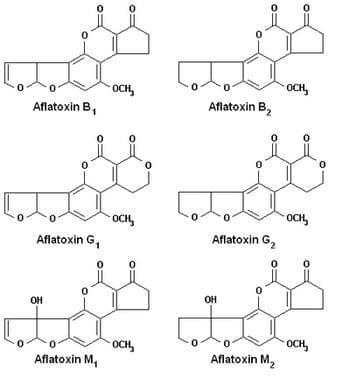
Figure 1. Chemical structures of the aflatoxin B1, B2, G1, G2, M1 and M2.
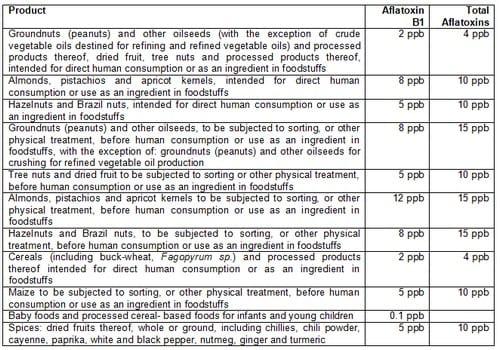
Table 1. Aflatoxin limits in fruit, cereals and milk expressed in μg/Kg (ppb) reference: Regulation (EC) 466/2001 of 8 March 2001 and its amendments: Regulation (EC) 472/2002, of 12 March 2002; Regulation (EC) 2174/2003, of 12 December 2003; Regulation (EC) 683/2004, of 13 April 2004; Regulation (EC) 1881/2006, of 19 December 2006; Regulation (EU) 165/2010 of 26 February 2010.

Table 2. Aflatoxin B1 limits in cereals expressed in μg/Kg (ppb). Reference: Directive 2003/100/CE of the commission, of 31 October 2003.

Table 3. Action levels established by FDA for total aflatoxins in food. Levels are expressed in ppb (μg/kg).

Table 4. Action levels established by FDA for total aflatoxins in livestock feed. Levels are expressed in ppb (μg/kg).
Materials and methods
Test principle: Celer AFLA B1 is a direct competitive enzyme immunoassay. The assay is performed in plastic microwells that have been coated with anti-AFB1 antibody. In premixing wells the enzyme-labelled aflatoxin and the standard solutions or samples are mixed and then transferred into the anti-AFB1 microtiter plate. During the first incubation, free AFB1 in the standard solution / sample and enzyme-labelled AFB1 compete for the anti-AFB1 antibody binding sites on the solid phase. Any unbound enzyme conjugate and aflatoxin molecule are then removed in a washing step. The bound enzyme activity is determined by adding a fixed amount of a chromogenic substrate. The enzyme converts the colourless chromogen into a blue product. The addition of the stop reagent leads to a colour change from blue to yellow. The absorbance is measured with a microplate reader at 450 nm. The colour development is inversely proportional to the AFB1 concentration in the standard solution or sample.
Assay time: 15 minutes.
Dosage range: 1-40 ppb.
Maize preparation: to 5 g of finely ground samples 1 g of NaCl and 25 ml of a solution of 70% methanol in distilled water are added. Samples are extracted by shaking thoroughly for 3 minutes and then filtered (Whatman n. 1).
Validation: the specificity of the assay was assested by analysing 12 blank whole maize samples (AFB1 < 0.5 ppb, HPLC analysis) run in duplicate within three different assays, for a total amount of 72 determinations. The cut-off was set by subtracting 2 Standard Deviations (SD) to the mean B/Bo value of blanks (USDA/GIPSA Program Notice FGIS-PN 04-15). The sensitivity was evaluated by spiking the blank samples at different levels, thus experimentally verifying the lowest quantitiy of quantificable AFB1 in matrix. The trueness was investigated by analysing four Reference Materials left over the proficiency tests of FAPAS (York, UK). The performances of the assay on maize were evaluated also partecipating to three AIA (Associazione Italiana Allevatori - Italian Breeders Association) proficiency test rounds.
Accuracy, intra- and inter-assay precision were investigated for spiked and incurred maize samples. The accuracy was expressed in terms of recovery rate of spiked quantity of AFB1; the precision was calculated by running three replicates of the same sample within one assay (intra-assay repeatibility) and repeating the analysis in different days (inter-assay reproducibility).
Apart from whole maize samples, two incurred maize germ samples were analysed by HPLC and by Celer Afla B1 in parallel to verify the correlation between confirmatory and screening results.
Results and discussion
Immunoassay performances
An example of the calibration curve is shown in Figure 2. The tolerance range of the IC50 value (ppb corresponding to 50% of maximum absorbance signal inhibition) is 2-8 ppb, taking into account its variability (mean value ± 3 SD, n = 38).
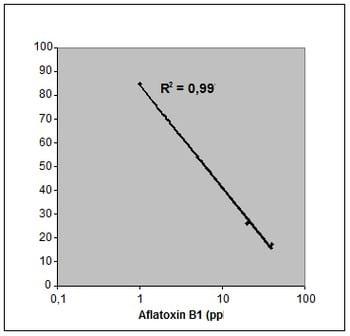
Figure 2. Celer Afla B1 mean calibration curve.
The cross-reactivity of the polyclonal antibody was determinated towards different aflatoxins. Results are reported in table 5.
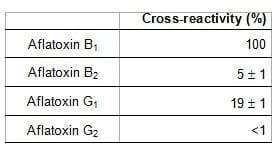
Table 5. Assay cross-reactivities set within three experiments (n = 3). For each aflatoxin, mean cross-reactivity and standard deviation are minuted.
It is therefore notable that Celer AFLA B1 has an high specificity for the AFB1, while for the other aflatoxins the cross-reactivity is lower than 20%.
Maize validation results
Specificity
12 blank maize samples (AFB1 < 0.5 ppb, HPLC analysis) were run in duplicate within three different assays, for a total amount of 72 determinations. 3 determinations turned to be higher than the detection limit of 1 ppb; the specificity was therefore 94.5%.
The mean B/Bo value of blanks was 93.7± 5.1%. By subtracting two standard deviations to the mean relative signal, the obtained B/Bo of 83.5% was higher than the first calibration standard B/Bo. It means that the cut-off was ≤ 1 ppb
The mean B/Bo value of blanks was 93.7± 5.1%. By subtracting two standard deviations to the mean relative signal, the obtained B/Bo of 83.5% was higher than the first calibration standard B/Bo. It means that the cut-off was ≤ 1 ppb
Sensitivity
The sensitivity was assested by spiking the blank maize samples with 1 ppb of AFB1. Some samples were extracted twice in order to obtain 20 replicates. 2 determinations turned to be < 1 ppb, the sensitivity was therefore 90%. The mean result was 1.20±0.20 ppb (mean recovery rate 120%). To obtain 100% sensitivity, an analysis was performed on 2 ppb spiked blanks: in this case, no determinations were < 1 ppb.
Trueness
Four Reference Materials provided by FAPAS were run within nine replicates each. AFB1 concentrations obtained for these materials were compared to the assigned values from FAPAS (determined by proficiency tests). The mean recovery for the four materials was 124±18%. Details are featured in the table 6.

Table 6. Results obtained by analysing four FAPAS maize Reference Materials (3 analysis, samples run in 3 replicates, for a total amount of 9 determinations each).
The performances of Celer Afla B1 were evaluated by partecipating to 2008-2009 AIA proficiency tests, as minuted in the table 7. All results were satisfactory, and achieved Z-scored were always < |1|.
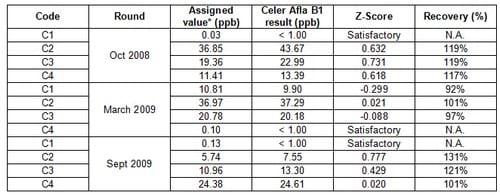
Table 7. Results obtained within the partecipation of different ring tests with both blank and contaminated maize samples.
* Assigned value were caluclated on the basis of confirmatory methods results.
Accuracy
Besides Reference Materials, recoveries were studied by spiking one blank maize sample at different levels (1 - 10 ppb). The mean recovery found for n = 36 determinations was 91 ± 21%, considered compliant to all screening requirements.
Precision
In the table 8 the intra- and inter-assay variability are shown for spiked, incurred and Reference samples.

Table 8. Intra- and inter-assay Coefficients of Variation established for both spiked, Reference and incurred materials.
Maize germ
Two incurred maize germ samples were analyzed for testing accuracy and precision. Aflatoxins content of these materials was determined by HPLC analyses performed in 3 different laboratories (detailed concentrations of materials in Table 9).
Recovery values obtained (90% and 105% for samples with 22.97 and 9.93 ppb of aflatoxin B1 respectively) showed the good accuracy of the kit on this matrix, with a very good mean recovery of 98% (Table 10).
Intra-assay precision was very good (< 6.4%) while inter-assay precision was satisfactory (26.5% at 9.93 ppb and 10.9% at 22.97 ppb) (Table 10). At the same time, the reproducibility of HPLC, when testing the aflatoxin B1 concentration on the same samples was 30% at 9.93 ppb and 38% at 22.97 ppb.

* The range was obtained by considering the mean ± SD of the 3 HPLC analysis.
Table 9. Detailed features of maize germs incurred materials determined by HPLC and used for validation of Celer AFLA B1.

Table 10. Recovery and precision results on maize germ samples.
Conclusions
The validation results obtained within the in-house experiments showed that the assay can be used as a specific, precise and accurate screening method for the quantitative detection of aflatoxin B1 in whole maize and maize germ. The test is extremely rapid (only fifteen minutes, apart from sample preparation) and easy to use. The sample preparation for maize is the same as for Celer Alfa, Celer DON, Celer FUMO, Celer ZON, that are ELISA test kits for the quantitative detection of total aflatoxins, deoxynivalenol, fumonisins e zearalenon respectively. Other validation data were collected for pistachios, hazelnuts, compound feed, raisins and dried figs: high sensitivity, good accuracy were obtained, in compliancy to the EU decision 98/53/CE.
References
McEvoy JDG. Contamination of animal feedingstuffs as a cause of residues in food: a review of regulatory aspects, incidence and control Analytica Chimica Acta, 2002, 473: 3-26
Vargas EA, Preis RA, Castro L, Silva CMG. Co-occurrence of aflatoxins B1, B2, G1, G2, zearalenone and fumonisin B1 in Brazilian corn Food Additives and Contaminants, 2001, 18 (11): 981-986
Sangare-Tigori B, Moukha S, Kouadio HJ, Betbeder A, Dano DS, Creppy EE. Co-occurrence of aflatoxin B 1, fumonisin B 1, ochratoxin A and zearalenone in cereals and peanuts from Côte d´Ivoire Food Additives and Contaminants, 2006, 23 (10): 1000-1007
Bircan C. Incidence of ochratoxin A in dried fruits and co-occurrence with aflatoxins in dried figs Food and Chemical Toxicology, 2009, 47(8): 1996-2001
Richard JL, Bennet GA, Ross PF, Nelson PE. Analysis of naturally occurring mycotoxins in feedstuffs and food J Anim Sci, 1993, 71:2563-2574.
Related topics
Authors:
Join to be able to comment.
Once you join Engormix, you will be able to participate in all content and forums.
* Required information
Would you like to discuss another topic? Create a new post to engage with experts in the community.
Create a post






.jpg&w=3840&q=75)